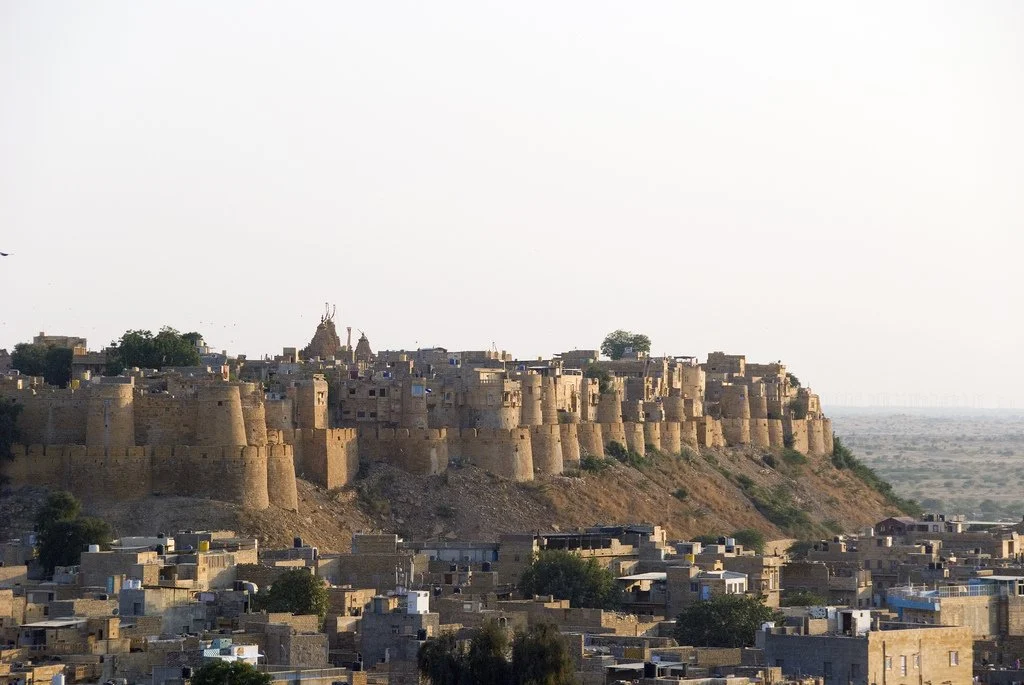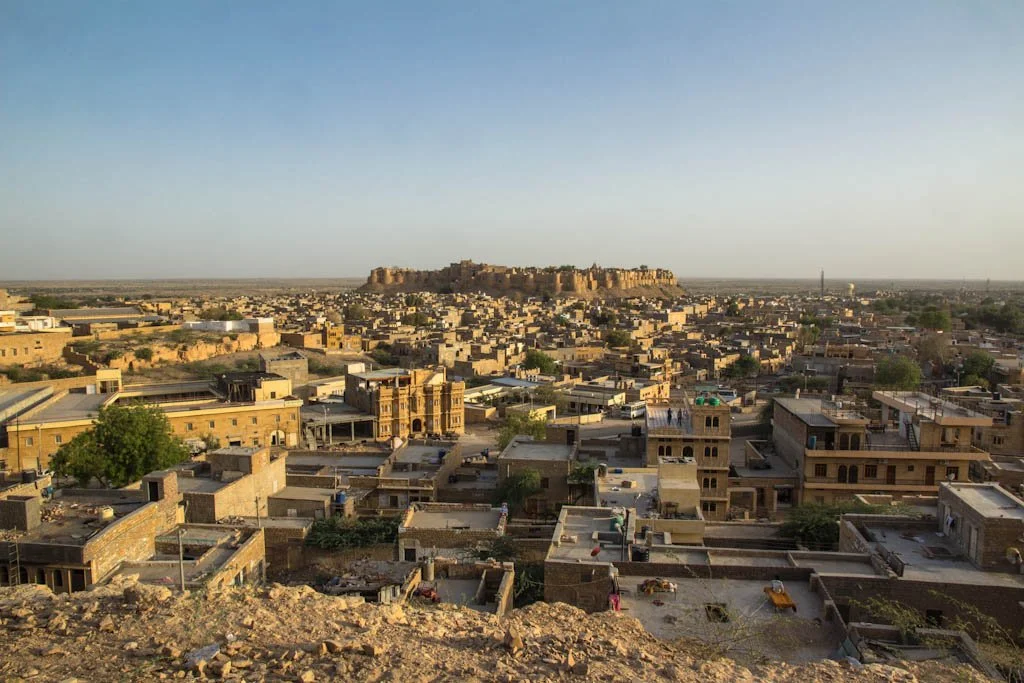Jaisalmer (जैसलमेर) is a city in the middle of the Great Indian Desert in the northwestern part of India in the state of Rajasthan. In January-February, Jaisalmer celebrates desert culture with an eventful Desert Festival. The program includes camel racing, camel polo, folk music, snake charmers, turban tying competitions and the famous Mister Desert contest. Many events take place in the dunes of Sam.
 |
| Jaisalmer India |
History
Jaisalmer was founded as early as 1156 by the head of the Rajput Bhati clan named Jaisal. Bhatis, who trace their lineage to Krishna, ruled until the country gained independence in 1947.
 |
| Jaisalmer India |
The city's early centuries were tumultuous, partly because its rulers profited from plunder, but by the 16th century Jaisalmer was prospering due to its strategic location on the routes between India and Central Asia. Ultimately, the city developed a strong relationship with the Mughal Empire. Maharawal Sabal Singh expanded the principality of Jaisalmer in the mid-17th century by adding areas that are now divided between the administrative divisions of Bikaner and Jodhpur.
 |
| Jaisalmer India |
Under the British, the development of maritime trade (especially through Mumbai) and railroads meant that the importance and population of Jaisalmer declined. The division in 1947, with the closure of trade routes to Pakistan, seemed to seal the fate of the city. But the wars in 1965 and 1971 between India and Pakistan gave Jaisalmer a new strategic importance, and since 1960, the Indira Gandhi canal in the north has brought life-giving moisture to the desert.
Today, the basis of the city's economy is tourism and a large number of military bases in the area.
 |
| Jaisalmer India |
Landmarks of Jaisalmer
Jaisalmer Fortress
The fortress was founded in 1156 by the Rajput ruler Jaisal, and subsequent rulers fortified it, so it became the object of a number of battles between the Bhatis, the Delhi Mughals and the Jodhpur Rathores. You enter the fortress from the east side and pass through four massive gates on your way to the top. The fourth gate leads to a large square, Dashera Chowk, where it becomes clear why the Jaisalmer Fort is considered unique: it is a populated fortress where about 3,000 people live. It is riddled with narrow, winding paths lined with houses and temples - and handicraft shops, guesthouses, restaurants and massage/beauty parlors. When walking around the fortress, watch your bags and pockets - there have been cases of theft.
Fortress Palace
Indian/foreigner including audio guide and photo Rs 30/250, video Rs 50/150;
8.00-18.00 April-October, 9.00-18.00 November-March
The elegant seven-story palace of the former rulers rises above the main square of the fortress and is partially built on Hawa Pol (the fourth gate of the fortress). The 1.5-hour audio guide is available in six languages, and it makes sense to take it, but you will need to leave a deposit of 2000 rupees or a passport / driver's license / credit card. The most interesting places are the mirrored and painted Rang Mahal (bedroom of the 18th century ruler Mulray II), a gallery of 15th century forged sculptures donated to the rulers by the builders of the fortress temple, and a breathtaking 360-degree view from the roof. And in one of the rooms there is an intriguing collection of stamps from the former Rajput states.
Jain Temples
Entrance 30 rupees, photo/video/mobile phone 70/120/30 rupees;
7.00-13.00
Within the walls of the fortress, seven beautiful yellow sandstone Jain temples, dating back to the 15th and 16th centuries, intertwine like a labyrinth. The intricate carvings of the temple rival those of the marble Jain temples at Ranakpur and Mount Abu and are of incredible quality due to the soft, warm stone. Before entering the temples, you need to take off your shoes and all leather goods.
Chandraprabhu is the first temple you will visit. It is dedicated to the eighth Tirthankara, whose symbol is the Moon. The temple was built in 1509. Here stands a statue in an almond, whose carved columns form a series of torans. To the right of Chandraprabhu is the quiet Rikhabdev Temple, with beautiful sculptures in glass cases along the walls and pillars adorned with beautiful statues of apsaras and gods. Behind Chandraprabhu stands Parasnath (Parasnath), where you get through a beautiful carved torana, which is crowned with the image of a Jain tirthankara. The door to the south leads to little Shitalnath (Shitalnath)dedicated to the tenth tirthankara, whose image is made of eight precious metals. A door in the north wall leads to the charming dark Sambhavanth hall in the forecourt; there Jain priests grind sandalwood in mortars for religious use. Steps lead down to Gyan Bhandar, a fascinating little underground library founded in 1500 that houses priceless ancient illustrated manuscripts. The other two temples, Shantinath and Kunthunath, were built in 1536 and feature many sensuous carvings.
Laxmi Narayan Temple (Laxminarayan)
The Hindu temple of Lakshmi Narayan, standing in the center of the fortress, is simpler than the Jain temples. It can be recognized by its brightly decorated dome. Believers offer grain, which is distributed before entering the temple. Inside the holy of holies there is an image hung with garlands, and in front of the entrance there is a convex silver architrave.
Haveli
Inside the fortress, and outside too (especially on the streets leading to the north), Jaisalmer is full of fabulous havelis - with luxurious carved stone doors, jalis (carved lattices), balconies and turrets.
Patwa-ki-Haveli
The whale in this haveli pond is Patwa-ki-haveli, which dominates the narrow street. Its intricate stone carving looks more like golden lace. The building consists of five sections and was built between 1800 and 1860 by five Jain brothers who made their fortunes in brocade and jewelry. The building makes the strongest impression from the outside. The first of the five sections is open as a private museum Patwa Ki Haveli (Indian/Foreigner Rs 50/120, photo/video Rs 40/70; 8.30-19.00) which reproduces life in the 19th century in great detail.
Salim Singh-ki-Haveli (Salim Singh-ki-Haveli)
entrance, including a guide 20 rupees,
photo / video 20/50 rupees;
8.00-19.00 May-September, 8.00-18.00 October-April
This 18th-century haveli has an amazing, distinctive shape. The top floor is replete with carvings and graceful arched balconies crowned with blue domes. Salim Singh was the prime minister of Jaisalmer in the 19th century and was notorious. His mistreatment of the Paliwal Brahmin community forced them to abandon their 84 villages and leave.
Nathmal-ki-Haveli
entrance 20 rupees;
8.00-19.00
This late 19th century haveli is also used as the prime minister's residence and is still partially inhabited. It is very unusual from the outside, all covered with carvings, and on the 1st floor there are beautiful paintings, which were painted using 1.5 kg of gold. British postcards from the 19th century and an image of Queen Victoria hang around the doorway. The left and right wing - the work of two brothers, whose spirit of competition and gave light to this work of art - are similar, but not identical.
Center and Museum of Desert Culture
Indian/foreigner 20/50 rupees,
photo/video 20/50 rupees;
9.00-20.00
Located next to the Tourist Reception Center. This interesting small museum has material in English and Hindi on the history of the different principalities of Rajasthan, exhibits on traditional Rajasthani culture. They include Rajasthani music (with video), textiles and phad paintings. Also in the evenings, half-hour puppet shows are held here (Indian/foreigner 30/50 rupees, photo/video 20/50 rupees; 6.30-19.30) with English commentary.
Center and Museum of Desert Culture
Indian/foreigner Rs 20/50,
photo/video Rs 20/50;
9.00-20.00
Located next to the Tourist Reception Center. This interesting small museum has material in English and Hindi on the history of the different principalities of Rajasthan, exhibits on traditional Rajasthani culture. They include Rajasthani music (with video), textiles and phad paintings. Also in the evenings, half-hour puppet shows are held here (Indian/foreigner 30/50 rupees, photo/video 20/50 rupees; 6.30-19.30) with English commentary.
Thar Heritage Museum
on the right side of the Kort road;
entrance 40 rupees
This privately owned museum near Gandhi Chowk Square displays an intriguing assortment of artifacts from Jaisalmer and the surrounding area. Most likely, the tour will be personally guided by the founder of the museum, local historian and folklorist L.N. Khatri. The museum's opening hours vary, but if it's closed, just look for Mr. Khatri at his Desert Handicrafts Emporium nearby on Court Road.
Gadi Sagar
This majestic 14th-century artificial reservoir southeast of the city walls was Jaisalmer's key source of water supply until 1965, and it is because of its importance that it is surrounded by many small temples. This is a favorite place for waterfowl in winter, but at the same time it can dry up almost completely before the rainy season. Catfish, which are the most numerous in the lake, accumulate in front of the shore in a wriggling mass when someone throws bread crumbs into the water. Boat rental (8.00-21.00) costs from 50 rupees to 100 rupees for half an hour.
It is said that the beautiful gate ki-Pol (Tilon-ki-Pol), which blocks the way to the reservoir, was built by a famous prostitute. When she offered to pay for the construction of the gate, the maharawal did not give permission for this, explaining that he would have to pass through them in order to go down to the pond, and this would be beneath his dignity. While he was away, the prostitute built the gate anyway, and to prevent the Maharawal from demolishing it, she decorated it with a statue of Krishna.